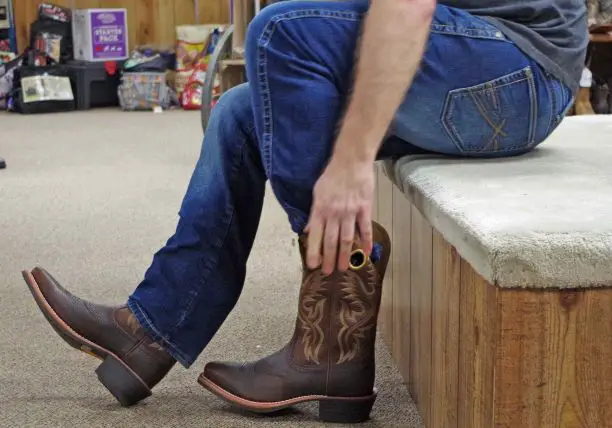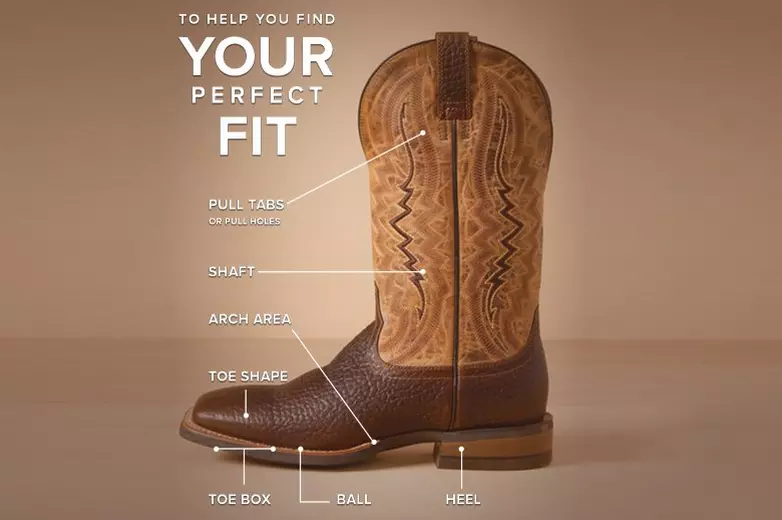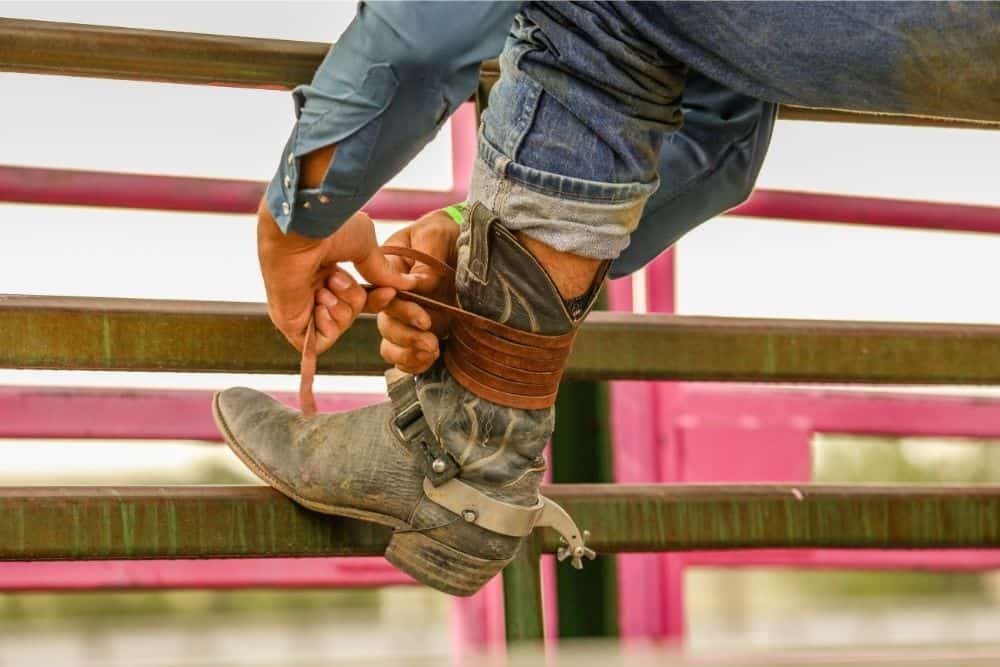Cowboy boots are an iconic form of riding footwear that has traditionally been worn by cowboys since many, many years.
But apparently, cowboy boots appear to fit differently than your average pair of sneakers or boots. Your boots should fit properly but should also be comfortable.
And cowboy boots also have a tendency to run a little large, so don’t be shocked if your boot size is smaller than your shoe size.
But what if your boots don’t fit you snugly around the calf?
There are many ways you can make your cowboy boots a little tighter around the calf if they’re running loose. Using a leather strap might help, or best take it to a professional.

Here in the article, we give you tips on how to make your cowboy boots fit properly.
But first, how should your cowboy boot fit around different areas of your leg?
1.) The instep- When it comes to judging if a cowboy boot fits, the instep is the most important component.
Instep is the area of the foot between the toes and the ankle and when you put on your boot, the upper section should softly touch your instep.
The concept is simple, if the leather on your instep feels too tight, the boot is too small and if it feels too loose, the boot is of a bigger size.
And when the fit around the instep isn’t exactly correct (too tight), the leather might block off blood flow to your foot, and as a consequence, you will experience numbness, which clearly indicates that you picked the incorrect size boot and should immediately replace it.
2.) The calf- Because boots extend all the way up to the calf, you’ll want to make sure your new pair is comfy around that area as well.
The shaft should be snug across your calf but not so tight that your ankles float within the boot.
Calf sizes vary from person to person. Larger calves may make it harder to lift the boot shaft by the straps or ears.
A good-fitting boot should have one to two inches of room around the calf.

3.) Toes- Another location to inspect is the toe to ensure the boot fits properly.
Cowboy boots have a variety of toe shapes. Some of the most prevalent include pointed-toe, square-toe, round-toe, and snip-toe.
And when it comes to selecting a new pair of boots, the size and structure of your toes will decide your ideal toe type.
Cowboy boots with pointed toes, for example, may be problematic for someone with a broad foot.
4.) Ball of the foot- The ball of the foot is the broadest section of the foot and it is an area that bends when you walk.
The broadest section of your foot should generally line up with the widest part of the boot.
However, how well your foot aligns with the boot will be determined by the brand and how well their boots are constructed.
Aligning the ball of your foot with the broadest section of the boot will allow you to flex your foot easily when taking a stride.
What if your cowboy boots are loose around the calf?
Not everyone’s calves are the same size obviously, which can be difficult to locate while looking for cowboy boots that fit. When it comes to calves, boot sizes vary, but your options are quite limited.
If you’re experiencing trouble with the calf fit, here are a few tips that will help you get sorted.
1.) Use a belt to tighten the grip around the calf
If you’re wearing your cowboy boots for appearance rather than for efficiency, a simple technique is to add a belt. It gives a new look to your boots while also maintaining the upper piece moulded to your calf.

Wrap the belt in a crisscross pattern around the shaft to the top, with the centre of the belt lower on the rear of the boot. When you fasten the belt, your boots are snug around your calves.
2.) Use a calf sleeve to hold on to the loose shaft
Calf sleeves are the most useful. They are similar to socks in appearance, but only stretch from the ankle to the calf.
Calf sleeves, rather than socks, can be used to cover the spaces between the calves and cowboy boots, making them fit tighter.
Furthermore, wearing calf sleeves improves blood circulation in your legs and supports leg muscles while you’re running or jogging.
3.) Wear thick socks or two socks at a time
Using thick socks or twin socks to help cowboy boots fit tighter on your calves is another option.
It helps fill the gap between the calves and the cowboy boots, allowing the boots to stay in place.
Thick socks can also be useful if you’re on your feet for long hours on rough terrain as it can help decrease shock and snuggle your feet to make you feel more comfortable.
However, this procedure will make your feet feel hot and tight so it is not advisable for those hot, summer days.
4.) Make use of warm water and socks to tighten the shaft area
This is a simple three-step procedure that only takes a few hours to complete:
• To begin, fill a bucket halfway with warm water and soak your boots in them for at least an hour. You want to ensure that the water has been absorbed by the boots.
• Do the same with a pair of old socks while the boots are soaking. Put on the damp socks and the boots. Wearing wet socks and boots will be unpleasant, but this step is important to mould the boots to your calf size.
• Continue to wear the boots and socks until they are totally dry. Wearing the boots until they are dry allows the leather to reconstruct to your shape and size. As the leather dries, the damp socks help it tighten into shape.
5.) Put on boot cuffs which will also protect you from cold
Boot cuffs are a winter item that might potentially alleviate your problem. They are a type of accessory that is typically used with tall boots in cold weather to keep the wearer warm.
Simply place the boot cuffs between the calf and the cowboy boots, filling the gap between them.
But they’ll be extremely unpleasant during warmer days.
6.) Consult a professional if the above tips don’t work for you
If you don’t want to wear wet boots and socks for a few hours and don’t want to use a belt, best take it to a professional who can adjust the size. It will not detract from the appearance of your cowboy boots, but will simply improve the fit.
The best idea is to seek the services of a skilled cobbler. They have the necessary abilities, expertise, and tools to do the task, and when you get your boots back, they will still look the same, but they will fit exactly around your calves.
All the above tips are useful if the calf area of your boots don’t fit you properly. But the most effective tip is to purchase a right fit in the first place to be free of the hassle.
So how can you make sure your cowboy boots fit perfectly while purchasing?
There are a few things you need to look for before purchasing-
1.) Try on the boot to check the shaft
When trying on a new pair of cowboy boots, first insert your foot all the way down the shaft of the boot.
Pull the shaft up your calf using the pull holes or straps on each side.
As you draw up the boot, you may encounter some pressure around the calf. However, if you have to tug too tight on the straps or holes, this is an indicator that the boot is probably too tiny.
2.) The fit should be proper and comfortable
Next, put on your boots. Then, using your index and thumb, estimate the distance between the tip of your toes and the end of the boot.
Comfort is an essential component and you cannot (should not) compromise on that.
The tip of your toe should be the length of your outstretched index finger and thumb for a great fit boot.
Make a point of walking around in your new footwear. You’ll get a better sense of how nicely the boot fits and how comfortable they are.
If the boots have too much heel slip, they will feel huge and heavy on your foot. The slip should also not be overly tight, since this will result in an unpleasant boot.
3.) Examine the heel lift
Heel lift is normal in new cowboy boots and will disappear as you break them in. This lift is the gap between your heel and the insole of the boot.
When there is some space between the toe of the boot and the instep, the heel lift occurs.
This gap is not always an issue, in fact, it enables your foot to fit tightly in the boot, nonetheless, it should be no more than 1/8 inch.
There may be some resistance around the inset region when you pull the boot shaft. This is not a reason for concern, it provides for the appropriate amount of heel lift.
Conclusion
There are a handful of do-it-yourself methods for shrinking cowboy boots that are too big for your calves. It is, however, recommended that you take it to a specialist who can handle it better.
However, in order to avoid disappointment and headaches later, you must first understand how to choose the correct match.
Remember that when purchasing new boots, you don’t need to utilise a different size technique or chart than you do for other shoes.







